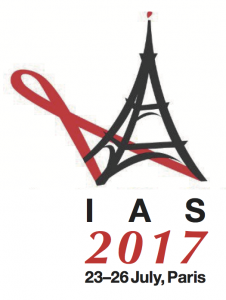Phase 3 results with bictegravir FDC: a new integrase inhibitor combined with FTC/TAF
10 August 2017. Related: Conference reports, Antiretrovirals, IAS 9th Paris 2017.
 Simon Collins, HIV i-Base
Simon Collins, HIV i-Base
Results from two phase 3 studies were presented at IAS 2017 on bictegravir, a new integrase inhibitor that is coformulated in a fixed dose combination (FDC) with FTC/TAF.
Bictegravir has already been submitted to the FDA for regulatory approval in the FDC formulation but it will only be available as a component of the FDC (B/F/TAF) rather than as a separate drug.
Both studies showed bictegravir to be very similar in efficacy to dolutegravir with slight differences in the formulations linked to the background NRTIs in the FDCs.
Bictegravir FDC compared to dolutegravir/3TC/abacavir
Joel Gallant from Southwest CARE Center, Santa Fe presented results of a phase 3 study that randomised 629 treatment naive participants to either B/F/TAF or the FDC dolutegravir/3TC/abacavir. [1]
Entry criteria included being HBV negative and B-5701 negative and having eGFR ≥50 mL/min.
Baseline characteristics included median age 32 years (IQR 18 to 71), 90% men: 10% women, 45% Caucasian, 36% black, 20% Hispanic/Latino.
Median CD4 count and viral load was 444 cells/mm3 (IQR 299 to 608), and 4.5 log copies/mL (IQR 4.0 to 4.9) respectively, with 11% of participants having CD4 <200 cells/mm3 and 16% with viral load >100,000 copies/mL. Median eGFR was 123 mL/min (IQR 107 to 146).
At week 48, the primary endpoint of viral load <50 copies/mL was reported in 92.4% vs 93.0% participants in the bictegravir vs dolutegravir groups (difference –0.6; 95%CI: –4.8 to +3.6, p=0.78) finding non-inferiority for the bictegravir FDC. Similar responses were seen in sensitivity analyses and for CD4 responses.
Side effects were similar between groups: diarrhoea (13% vs 13%), headache (11% vs 14%), and nausea (10% vs 23%) in the bictegravir vs dolutegravir FDCs respectively. Few people (n=0 vs 4) discontinued due to side effects.
Other side effects were also similar. The mean percentage changes in bone mineral density (BMD) in lumber spine and total hip were –0.83% vs –0.60% (p=0.39) and –0.78% vs. –1.02% (p=0.23) respectively. There were no differences between treatments for eGFR or proteinuria. There were modest increases in all lipids, including HDL, but no differences between groups.
Bictegravir FDC compared to dolutegravir plus FTC/TAF
The second study included 48-week results from a phase 3 study with dolutegravir plus FTC/TAF as background NRTIs, presented as a poster by Paul Sax from Brigham and Women’s Hospital, Boston. [2]
This blinded placebo-controlled study randomised 645 treatment-naive participants with eGFR ≥30 mL/min to either B/F/TAF (50/200/25 mg) or dolutegravir (50 mg) plus separate F/TAF (200/25 mg) each with matching placebos. All regimens are once-daily.
Baseline characteristics included median age 34 years, 12% women and 31% black. Median CD4 and viral load were 440 cells/mm3, and VL 4.4 copies/mL respectively with 12% CD4 <200 cells/mm3 and 19% viral load >5.0 log copies/mL.
At week-48, viral load was <50 copies/mL in 89.4% vs 92.9% of participants in the bictegravir vs dolutegravir arms respectively (difference –3.5%; 95%CI –7.9% to +1.0%, p=0.12), showing noninferiority based on lower margin of –12%.
Side effects again were similar in each group: headache (13% vs 12%) and diarrhoea (12% for both) with few discontinuations (n=5 vs 1) and no serious renal events.
The only other poster about bictegravir was a pharmacokinetic study showing similar drug levels in Japanese compared to Caucasian HIV negative volunteers. [3]
comment
Both study results show that bictegravir is very likely to soon be approved in the B/F/TAF formulation.
In high- and middle-income countries where the bictegravir FDC is likely to first be used, access is likely to be dependent on drug pricing, even with the advantage of not requiring B*5701 and HBV testing before use.
In low-income countries with access to generic dolutegravir, the generic FDC will be coformulated with F/TAF rather than abacavir/3TC.
The bictegravir FDC was submitted to the FDA in June 2017 and to the EMA in July 2017. The FDA application included a priority review with a decision expected by February 2018. [4]
References
- Gallant J et al. A phase 3 randomized controlled clinical trial of bictegravir in a fixed dose combination, B/F/TAF, vs ABC/DTG/3TC in treatment-naïve adults at week 48. IAS 2017, Paris. Late breaker oral abstract MOAB0105LB.
http://programme.ias2017.org/Abstract/Abstract/5783 - Sax P et al. Phase 3 randomized, controlled clinical trial of bictegravir coformulated with FTC/TAF in a fixed-dose combination (B/F/TAF) vs dolutegravir (DTG) + F/TAF in treatment-naïve HIV-1 positive adults: week 48 results. IAS 2017, Paris. Late breaker poster abstract TUPDB0201LB.
http://programme.ias2017.org/Abstract/Abstract/5793 - Custodio J et al. A study evaluating the pharmacokinetics, safety, and tolerability of the bictegravir/emtricitabine/tenofovir alafenamide (B/F/TAF) single tablet regimen (STR) in Japanese subjects. IAS 2017, Paris. Poster abstract MOPEB0332.
http://programme.ias2017.org/Abstract/Abstract/2777 - Gilead press statement. Gilead announces U.S. FDA priority review designation for fixed-dose combination of bictegravir, emtricitabine and tenofovir alafenamide for treatment of HIV. (10 August 2017).
http://www.gilead.com/news/press-releases

